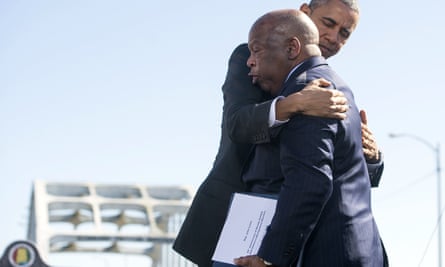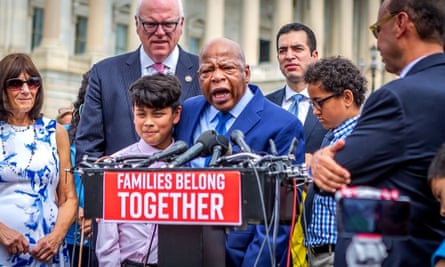The life of the US congressman John Lewis, who has died aged 80 after suffering from pancreatic cancer, is a paradigm for the history of race relations in the US over those eight decades. Born into segregation, Lewis took a leadership role in civil rights protest as a young man, and was at the heart of many of the most crucial, and dangerous, events in that movement. He was beaten by the Ku Klux Klan and by the police, jailed repeatedly, and continually forced to move forward while ignoring friendly voices warning him not to push too hard against the apartheid legislated in large parts of America.
As the changes for which he battled came into being, he found himself elected to the US House of Representatives, where he also served in leadership positions, and was called “the conscience of Congress” by the Atlanta Journal-Constitution. And while he saw a black man elected president, he then watched as many of his movement’s hard-fought gains were walked back by reactionary judges, senators and, indeed, a president.
Right at the start of his campaigning career, as one of the leaders of the Nashville Student Movement in Tennessee, Lewis was arrested multiple times while organising sit-ins against the city’s segregated restaurants and bus services. In 1960, along with a similar student group in Greensboro, North Carolina, he and Nashville colleagues Diane Nash and Marion Barry (a future mayor of Washington) were at the heart of the founding of the Student Non-Violent Coordinating Committee (SNCC, pronounced “Snick”), encouraged by Martin Luther King’s Southern Christian Leadership Conference, but more committed to widespread student-led local action. Other SNCC leaders included the future black power leader Stokely Carmichael and the future Georgia politician Julian Bond, from Morehouse College, in Atlanta.
Lewis was one of the 13 original Freedom Riders, organised by the Congress of Racial Equality (Core). Because interstate bus travel was regulated by federal law, which prohibited segregation, the riders looked to force the issue while travelling through southern states in 1961. While trying to use whites-only facilities in a bus station in Rock Hill, South Carolina, Lewis became the first rider assaulted, as two men beat and kicked him.

The entire group was attacked in Anniston, Alabama, other buses were set upon and one firebombed. When the Core leader James Farmer moved to discontinue the rides because of the violence, Lewis, Nash and their Nashville group took them over. Lewis eventually spent 40 days in jail in Mississippi, while the attorney general, Robert Kennedy, called for a “cooling-off” period and a halt to the rides.
Becoming chairman of SNCC in 1963 made Lewis one of the “big six” organisers of the March on Washington, where King delivered his “I Have a Dream” speech. Lewis dropped a key line – “which side is our government on?” – from his own speech, persuaded by the other leaders not to risk offending the Kennedy administration. But the following year, Lewis was at the forefront, literally, of SNCC’s leadership of the Mississippi Freedom Summer, which saw the murders of the civil rights workers James Chaney, Michael Schwerner and Andrew Goodman in Neshoba county.
In 1965, Lewis and Hosea Williams led the freedom marchers across the Edmund Pettus bridge in Selma, Alabama, where they were attacked by state troopers, police and bystanders. The scenes of violence were broadcast across the country, with Lewis bloodied by a baton that fractured his skull. The television interview he gave calling on President Lyndon Johnson to take action could be seen as the crucial moment in winning public support for equal rights.
Lewis left SNCC in 1966 and became chairman of the Voter Education Project, aimed at registering minority voters. In 1977 he ran for the congressional seat in Atlanta vacated by Andrew Young when he became Jimmy Carter’s ambassador to the United Nations, but he lost the Democratic primary to Wyche Fowler, and instead joined the Carter administration’s Action programme, uniting a number of volunteer schemes including Vista, the domestic version of the Peace Corps. He was elected to the Atlanta city council in 1981, and in 1986, when Fowler left the House to run for the US Senate, Lewis staged a bitter primary fight to replace him against his old colleague, Bond, downplaying the latter’s civil rights activism and accusing him of corruption and drug use.

Lewis won the primary in an upset, then easily took the election in what is a safe Democratic seat. He was re-elected 16 times, never with less than 69% of the vote, running unopposed six times. Considered one of Congress’s most liberal Democrats, he remained fiercely independent. He voted against the first Iraq war, boycotted the inauguration of George W Bush, whose election he considered illegitimate due to voter fraud in Florida, and similarly refused to attend Donald Trump’s inauguration in 2016.
But he also gave Bush his vote for the emergency powers resolution after the 9/11 attack, though he later called for Bush’s impeachment for abusing those powers. Ironically, it was Bush who in 2003 signed into law a bill Lewis had introduced every year since he entered Congress, to establish a Museum of African American History in Washington. His opposition to policy was bipartisan. He also clashed with Bill Clinton a number of times, including over the North American free trade agreement.
Never losing his belief in the power of protest, he was arrested twice at the Sudanese embassy demonstrating against genocide in Darfur, and once outside Congress calling for immigration reform. He led a 26-hour sit-in in the House when the Senate refused to take action on gun control following a 2016 mass shooting in Orlando.
He endorsed Hillary Clinton as the Democratic nominee for president in 2008, but in February switched his support to Barack Obama, calling his candidacy “a great leap” for America. After Obama’s election, Lewis was asked if this were the fulfilment of King’s dream. He replied: “It’s just a down payment.”
He again endorsed Hillary in 2016, with an ad hominem attack on her rival Bernie Sanders, saying that during his time as chair of SNCC from 1963 to 1965, “I never saw him, I never met him ... but I met Hillary Clinton”. This was controversial as Sanders was arrested in 1963 for leading civil rights protests in Chicago, while Hillary at that time was still at school and a supporter of the “states rights” Republican Barry Goldwater.
John was born in Troy, Alabama. His mother, Willie Mae (nee Carter), and father, Eddie Lewis, were sharecroppers in rural Pike county; John often noted that as a small child he had only ever seen two white people. He went to local country schools, then to the segregated Pike county vocational high school, where his studying was hampered by the lack of access to Troy’s whites-only libraries.

Troy State University (now Troy University) was also whites-only, and all-black Morehouse College, where he hoped to study, was too expensive. Considering an attempt to integrate Troy State, Lewis wrote to King, who forwarded the bus fare to Montgomery, Alabama. This meeting with King and Ralph Abernathy ignited Lewis’s lifelong commitment to non-violent protest, but, on their advice, he enrolled at the American Baptist Theological Seminary (now the American Baptist College) in Nashville, where on-campus work could help pay for his tuition. Eventually, he transferred and took his degree in religion and philosophy at nearby Fisk University.
Lewis’s 1998 autobiography Walking With the Wind (written with Michael D’Orso) was followed by a 2012 memoir, Across That Bridge (written with Brenda Jones). He had huge success with a best-selling graphic novel trilogy, March (2013-17), co-written with Andrew Aydin, which has become a standard teaching tool about the civil rights movement.
Dawn Porter’s just-released documentary John Lewis: Good Trouble moves between the civil rights activism of the 1960s and footage of Lewis on the campaign trail for the 2018 midterm elections. The “good trouble” insistence on the need for non-violent struggle against injustice and shaky institutions remains a constant, notably in relation to voter suppression, a main issue, particularly in Georgia, for the 2020 elections.
Lewis’s philosophy might be summed up in a question he asked while opposing Bill Clinton’s neoliberal welfare “reform” bill in 1996: “Where is the sense of decency? What does it profit a great nation to conquer the world, only to lose its soul?” That he lived to see Confederate monuments topple as a vast majority of the nation rose in protest supporting the Black Lives Matter movement after the police murder of George Floyd was a tribute to his life of struggle.
His wife, Lillian Mills, whom he met at a New Year’s Eve party and married in 1968, died in 2012. He is survived by his son, John-Miles.
John Robert Lewis, politician and civil rights leader, born 21 February 1940; died 17 July 2020